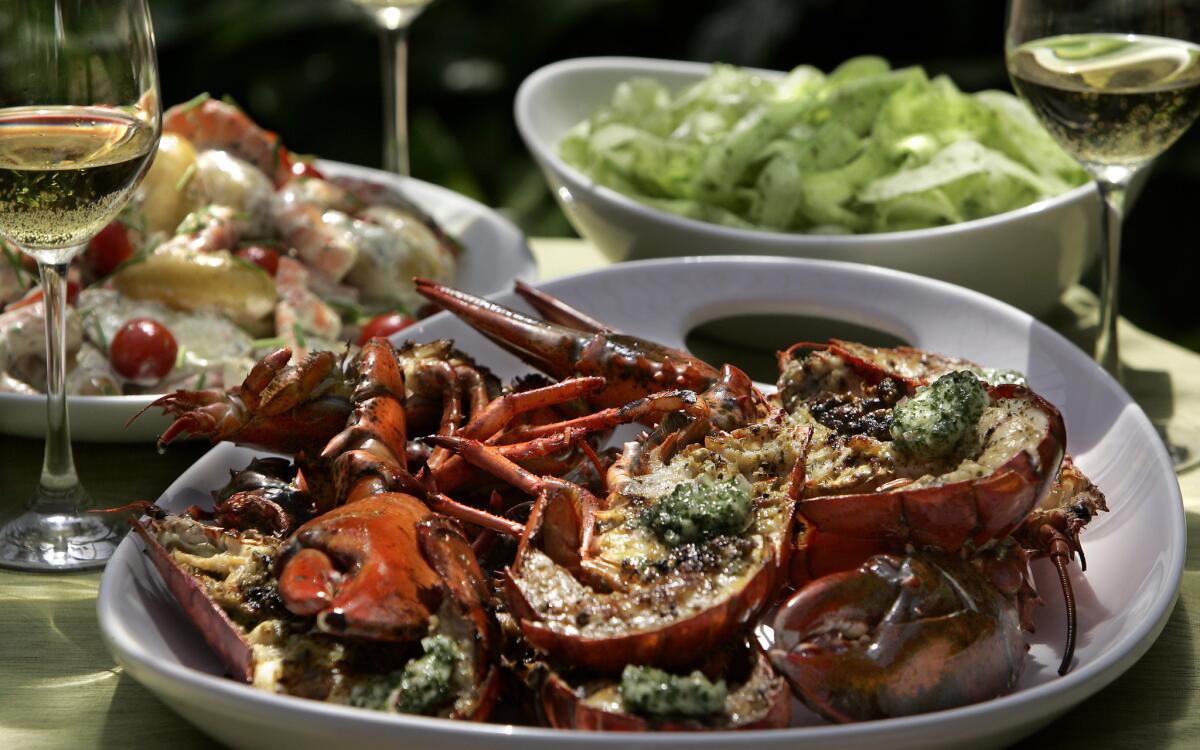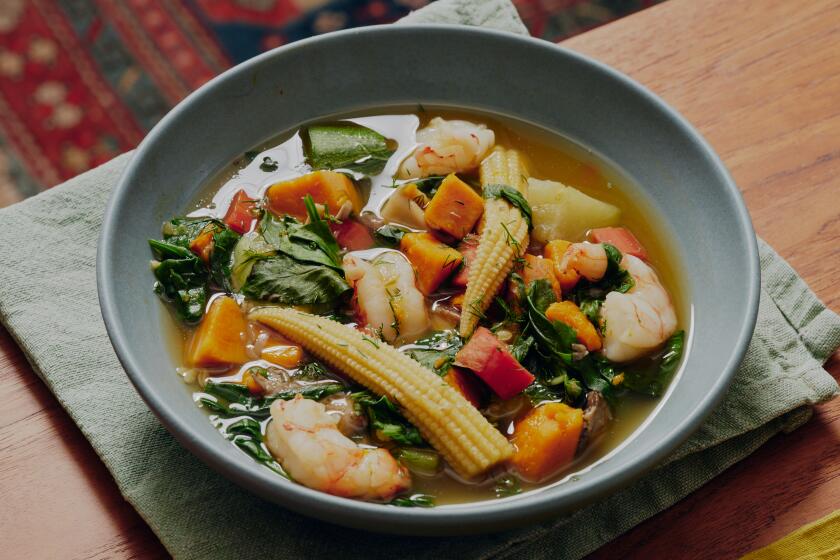Grilled lobster with shallot butter and cucumber `noodles'

- Share via
Sweet lobster delicately scented with wood smoke and moistened with shallot butter, paired with crisp ribbons of cucumber. Creamy new potatoes and meaty shrimp lightly bound with a punchy herbal mayonnaise. Freshly made strawberry ice cream melting into warm buttery biscuits.
No, it’s not your traditional backyard barbecue menu, but if you look closely at each dish, you’ll see that it’s not far off. And when you put them all together, you have a wonderful meal for a warm summer night. Pull the cork on a cold bottle of crisp white wine, gather friends in the garden, and you’re getting the season off to a great start.
A meal such as this is not about re-inventing the wheel, but about giving old favorite flavors a gentle twist. There’s nothing like seeing a familiar face in a fresh setting to make it fascinating again. Shave cucumbers into celadon noodles and you have a terrific bed for grilled lobster; not until you taste it do you recognize the combination of cucumber and dill.
Punch up potato salad with a savory dressing instead of the same old mayo. Add poached shrimp and you’ve got an elegant appetizer.
To finish the menu, what about strawberry shortcake? No, wait: What about strawberry ice cream? Hey, what about both?
Let’s start at the beginning of the meal. Take fingerling potatoes and steam them until they’re nice and creamy, then toss them with a little green goddess dressing.
“Green goddess?” I hear you ask. If all you’ve ever had is the bottled version of this, you might well be surprised. But taste the real thing and it will immediately become one of those recipes you keep going back to time after time.
The real green goddess is one of the classic American salad dressings. It was invented in the 1920s by Philippe Roemer, the chef at San Francisco’s Palace Hotel. And far from the insipid version that you find in the grocery store, green goddess, as Roemer conceived it, is complex with chives, parsley and tarragon and has a tangy punch that comes from green onions and anchovies.
This is the kind of mayonnaise that enlivens everything it touches. It is equally delicious binding a composed salad of crab and avocado or smeared on a grilled slab of salmon.
It also brings out the best in new potatoes, accenting their delicately earthy flavor and complementing their almost buttery texture. In fact, add a little something for heft -- like poached shrimp, for example -- and a simple potato salad becomes a knockout dish you can use to kick off a dinner party.
Even better, the potato salad can be prepared the day before, considerably easing your last-minute cooking chores. Just let it come to cool room temperature before serving.
Because of the big herbaceous flavors of the green goddess, serve a juicy Sauvignon Blanc to accompany it -- something in the style of the ones made by Voss Vineyards or Geyser Peak Winery.
Ribbony texture
Every change doesn’t need to be so dramatic. With a flavor combination as natural as cucumber and dill, you need only a gentle tweaking. Rather than slice the cucumbers crosswise into coins, you can get a different effect by shaving them into ribbons.
It’s just a small change but the difference is striking. Instead of this unruly stack of wheels that roll all over the plate, you’ve got a mound of beautiful noodles that range in color from ivory to celadon. Because the cucumbers are sliced so thin, the texture is pasta-like too, with a pleasing hint of crispness.
Dress them very simply with only a little bit of Champagne vinegar and some snipped dill. You don’t need to add any oil at all because the cucumbers have so much juice of their own.
Though the ribbons can be sliced a couple of hours in advance, don’t season them until the last minute. Otherwise, the salt will draw the moisture from the cucumbers, making them limp and soggy.
This crisp-tender texture and subtle flavor make these cucumber noodles a perfect match for grilled lobster. And so does its ease of preparation. As simple as lobster is to prepare, getting it just right takes attention. It’s good to have a dish that’s a no-brainer to pair it with.
Lobster is always a little resilient -- that texture is one of its pleasures. But though cooking it on the grill does lend the subtle perfume of the open fire, keeping the meat from becoming downright chewy -- and dried out, to boot -- takes careful timing.
The trick is cooking it over a moderately hot fire. That will set the outside of the meat quickly while minimizing the risk of overcooking the center. Start out with the cut side down and grill it just long enough that the flesh begins to mark and you can see it start to firm up. That’ll take only two or three minutes.
At that point, turn the lobster over and keep grilling until the meat pulls cleanly away from the shell and just begins to flake when poked with a paring knife, about five minutes more.
Remove the lobster from the fire and slide a coin of compound butter over the tail. Made with shallots, lemon and parsley, the butter will melt into the meat, keeping it moist and flavoring it. Transfer the lobsters to a platter while you’re dressing the cucumbers; the reserved heat will finish cooking them through.
If you want to keep the menu West Coast-centric, substitute salmon for the lobster. Grill the fish or try oven-steaming it: Cook the salmon on a cookie sheet in a 250-degree oven over a baking pan of boiling water. The color stays that magnificent orange and the texture firms but still stays buttery.
A hint of butter
To go with the lobster, choose a moderately rich California Chardonnay -- nothing too drastically old-school oaky, but a wine with a little butter in it. Think of something such as Beringer or Edna Valley Vineyard.
For dessert, try combining two American classics, strawberry shortcake and strawberry ice cream. Rather than serving strawberries topped with whipped cream, freeze the two together to get something spectacular. Bake the shortcakes right before serving so they’re still warm, and combine the two elements at the last minute so the ice cream softens and begins to melt into the shortcake, moistening it and making it even richer. It’s like strawberry shortcake, only more so.
When making the ice cream, it’s important to sugar the strawberries well in advance of freezing. This softens the berries and draws out much of their moisture, keeping them from turning into little red ice cubes in the freezer. The juice from the berries will tint the ice cream a delicate pink.
The ice cream can be made a day ahead, but no more than that. The base is uncooked, which preserves that wonderful, fresh cream flavor (juiced up by the addition of a little sour cream). But ice creams made this way do go icy faster than ones made with cooked custard.
On the other hand, how long does fresh strawberry ice cream usually last in your house, anyway?
Put the butter in a small mixing bowl and roughly beat in the minced shallots, parsley and lemon juice with a spatula or fork. Form the butter into a rough log about 5 inches long on a sheet of wax paper. Roll it tightly to form the log into a smooth cylinder and twist the ends to seal. Refrigerate until firm, at least 1 hour.
Peel the cucumbers, removing the tough green skin. Then continue peeling, shaving long thin strips like pasta noodles. It’s easiest to do this with the cucumber resting on a cutting board, leaving one end of the cucumber unpeeled for a better grip. Keep rotating the cucumber so you’re peeling around the seedy center without cutting into it. When you get to the seeds, stop. Discard the center with seeds. You should have about 4 cups of long strips about one-half-inch wide.
Heat the grill over a medium-hot fire. In a small saucepan, melt half of the shallot butter over low heat.
On a sturdy cutting board using a heavy, sharp chef’s knife, kill and halve the lobsters lengthwise. First, drive the point of the knife down through the head of the lobster where the base of the head joins the body, bringing the knife all the way down to split the head in two lengthwise; this will kill the lobster. Continue cutting the lobster in half lengthwise. Remove the vein that runs along the top of the tail (as with shrimp), as well as the sac near the head. Using the back of a heavy chef’s knife or the flat side of a kitchen mallet, give the claws a good crack.
Brush the lobster meat with the melted butter, place the halves meat-side down over the medium-hot fire. Cook just until flesh is marked and starting to firm, about 2 minutes.
Turn the lobsters over, cover the grill, and continue cooking until the meat is firm and starting to pull away from the shell, about 5 to 7 minutes. Brush occasionally with any remaining melted shallot butter. When the lobsters are done, remove from heat to a platter and keep in a warm place.
When almost ready to serve, sprinkle the cucumbers with the salt, dill and vinegar; toss to combine. Do not season the cucumbers in advance or they will wilt and become mushy.
Cut the remaining chilled butter into 6 coins and place one on top of each lobster tail. Serve immediately with the cucumber strips alongside.
Get our Cooking newsletter.
Your roundup of inspiring recipes and kitchen tricks.
You may occasionally receive promotional content from the Los Angeles Times.















